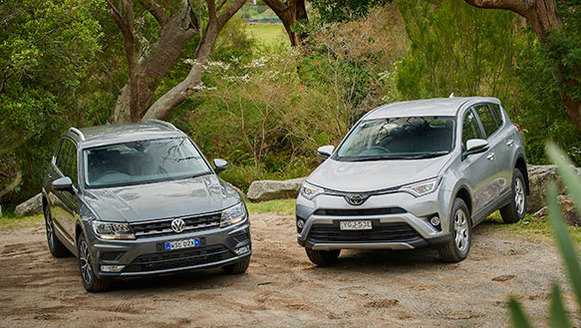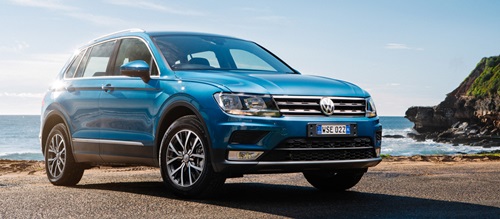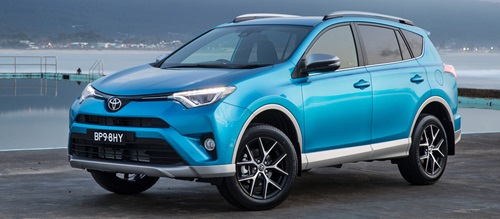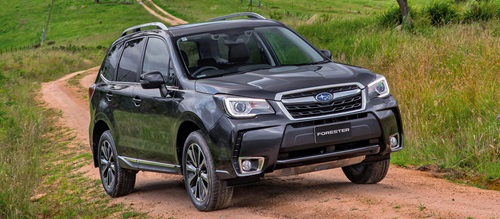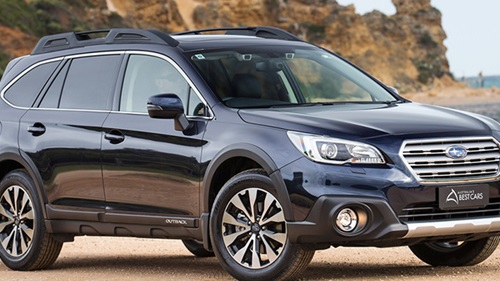Fast forward a couple of decades and SUVs have not only become the latest fashion statement, but have replaced the quintessential Aussie family car – think Holden Commodore and Ford Falcon.
SUVs are no longer about getting off the beaten track. Instead they have a clear focus on style, cache and comfort. The 2016 Volkswagen Tiguan is one of the best examples of this new breed of SUV.
So is the traditional rugged SUV still relevant? We got the 2016 Toyota RAV4, and the 2016 second generation VW Tiguan together to find out.
Comfort and convenience
It must be noted that the Toyota RAV4 in GX form is the base model, whereas the Comfortline Tiguan is the mid-spec. When looking at specifications, we've used the GXL model for a fairer comparison as it's closer in price to the Tiguan. The GXL (with the optional safety pack) is priced from $45,357 driveaway and the Comfortline Tiguan as tested is priced from $49,238 drive away.
The Volkswagen's seats have better bolstering than the RAV's but the longer seat cushion in the RAV provides better under-thigh support. Both are manually adjustable only. The Tiguan has keyless entry but not ignition. In GXL spec the RAV gets both. Neither has power-operated tailgates. This is part of a $5000 optional luxury package on the VW and only available on the flagship RAV4 Cruiser.
Space and practicality
The RAV is slightly longer, wider and taller than the Tiguan but the Tiguan is better packaged and has more front head and leg room and also more rear head room. The RAV has longer seat cushions in the front and better seat travel. It also has more leg room and more rear seat width.
The RAV's cargo area is slightly longer, wider and higher than the Tiguan' and more length with the rear seats folded. However, there is no 12-volt power socket, levers to drop the rear seats, or even a light. The Tiguan has all three, making it more practical.
The RAV's centre console and glovebox are larger but both cars have two cup holders and bottle holders front and rear. The Tiguan also has very handy 'aeroplane-style' folding tables on the back of the front seats. We also liked that the Tiguan's cup holder arms can be retracted to form one larger storage area that has a sliding cover. Both have illuminated vanity mirrors for the driver and front passenger.
Ergonomics
The RAV has a very utilitarian feel to it inside, and a certain robustness suggests it will have longevity. There are large buttons and a basic driving position. The RAV's layout is simple, but it's no match for Tiguan's ergonomics.Everything in the VW is laid out so that it falls to hand. The Tiguan's eight-inch colour touch screen media system includes Apple CarPlay, Android Auto or MirrorLinkR. The VW's centre dash is more angled towards the driver and the larger touch screen is easier to read, and reach, than the RAV's smaller unit. It's also considerably easier to operate and has loads more functionality and technology. The GXL RAV does get satellite navigation with DAB Radio, but not a bigger screen.
Both have optional dash instrument displays. The RAV has a 4.2-inch multi-information display unit (as part of the safety pack) that shows the usual driving information such as distance to empty, average fuel use etc. It's an analogue display with LED instrumentation.
The Tiguan has the optional 12.3-inch Active Info display (as part of the driver assistance pack). The design is sleek and stylish and the dash display, borrowed from Audi, adds a new level of quality feel to the class. Drivers can personalise the instrument display with six different views. There are multiple customisable menus within the instrumentation that control most of the car's functions.
Performance
Both cars are powered by four-cylinder engines – the RAV houses a 2.5-litre naturally aspirated engine paired with a six-speed automatic, while the Tiguan has a 2.0-litre turbocharged unit mated to a seven-speed DSG.The pair are line-ball for power, but the VW almost 100Nm more torque. Overall, acceleration is strong, gear changes are quick and smooth, and the Tiguan is quiet. The engine does suffer turbo lag, however, when you want to accelerate quickly, something accentuated by the dual clutch gearbox. The hesitation tends to kick in when you least want it – i.e., accelerating into a gap or turning across traffic at an intersection. It is more noticeable in Eco and Normal driving modes, but with the change in engine mapping in Sport mode, it's nowhere near as pronounced.
With the RAV it's a case of put your foot down and go. There are no DSG oddities or lag. The naturally aspirated engine and regular six-speed auto work well together and make the drive feel lively and more linear.
Once up and going, however, the VW's engine does pull better in the mid-range and is more responsive for in-gear acceleration.
Economy
Both cars have 'eco' modes but the VW's smaller engine and DSG transmission (despite its foibles) are more economical, although there's not a lot in it. In our real world tests, the VW used an average of 8.9L/100km while the RAV used 10.1. The RAV sips the cheaper unleaded fuel, not premium as is recommended in the Tiguan.Ride and handling
On the road, the Tiguan excels. The first generation was a good drive, but the new model is definitely better. The Tiguan is composed and refined with a smooth, comfortable ride. Over big bumps, however, the suspension crashes and jars. Steering feel is direct and communicative in normal mode, but you can feel the difference in Sports mode. The Tiguan stays flat and composed when cornering. On the dirt, the Tiguan is surprisingly quiet but is not as composed as expected. It skips about and gets unsettled over ruts and corrugations, although our test car was shod with road biased wheels.The RAV4 is much softer sprung and tends to waft about a bit. Body control is not as good on the black stuff and its low-speed ride can be a bit jittery, but it is confident and feels secure in its roadholding. On rougher roads, however, the RAV handles larger irregularities well and is more composed on the dirt than the Tiguan – although the Tiguan is noticeably quieter on dirt roads.
Safety
Both cars come with a five-star ANCAP rating. Standard safety equipment on the Tiguan Comfortline includes front assist with city emergency brake, lane assist, seven airbags, electronic stability control, 4MOTION Active Control all-wheel drive, anti-lock brakes, electronic brakeforce distribution, brake assist, Active bonnet, pedestrian protection Automatic flashing brake lights activated in emergency braking situation, Electro-mechanical parking brake Our test car came with the optional ($2000) advanced safety package that further adds adaptive cruise control, Side Assist with Rear Traffic Alert, Active Info display, power folding door mirrors and area view.Standard safety on the RAV4 includes: seven airbags, electronic stability control, Dynamic Torque Control AWD, anti-lock brakes, electronic brakeforce distribution, brake assist and brake assist. Like the Tiguan, the RAV came with an optional ($3800) advanced safety package that further adds autonomous braking, active cruise control, automatic high beam, lane departure alert with steering assist, rain-sensing wipers, front parking sensors and a sway warning system to aid when towing. The pack also adds satellite navigation, the 4.2-inch colour multi-information display, upgraded instrument cluster, digital radio, dusk-sensing headlights, fog lights and revised front bumper (to house the radar).
Build quality and finish
The RAV feels robust in its build quality, while the build quality in the Tiguan we tested was not as good as expected (unusual for VW). There was a noticeable panel gap on the side of the glovebox, the multimedia screen didn't sit flush and there was a rattle on the driver's side door.Having said that, however, the VW's cabin is considerably classier and more premium. The RAV has been 'tarted up' in the recent facelift, but it's already three years old, which, in car terms these days, is an eternity. The Tiguan has nicer trim highlights, a leather-wrapped steering wheel (the Toyota's is plastic!) and more tactile switchgear. The graphics on the infotainment system, not to mention the stunning digital dash display, are streets ahead of the RAV's.
Refinement
For overall refinement the Tiguan is definitely the pick. The RAV is more rugged, its cabin is not particularly nice and it feels very outdated and basic compared with the Tiguan. It's noisier on and off road, and not as composed as the Tiguan.Cost of ownership
Both cars come with a basic three-year warranty. The Tiguan's is unlimited kilometres, the Toyota is capped at 100,000km. The majority of people, however, won't reach 100,000 in three years.The RAV4 costs $1080 to service over the three years, compared with the VW at $1763 (includes additional items that have to be replaced in the three years such as pollen filter and brake fluid).
Final thoughts
So, is the traditional SUV still relevant? That depends on your lifestyle! If you're going to spend more time off the beaten track, then the ruggedness of the RAV4 becomes part of its appeal. Not to mention Toyota's reputation for bulletproof reliability, especially if you're planning on exploring the great outdoors.However, if you're going to spend most of your time on sealed roads, then the new breed of SUV is the better choice. The Tiguan is a refined, premium offering better suited to the urban lifestyle.







